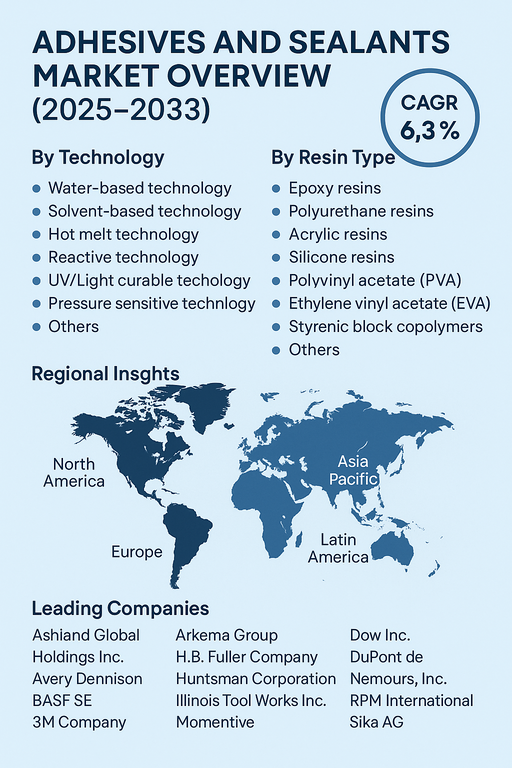The global adhesives and sealants market is projected to grow at a CAGR of 6.3% from 2025 to 2033. Market growth is driven by increasing demand across construction, automotive, packaging, electronics, and healthcare industries. Adhesives and sealants are essential for bonding, sealing, and protecting materials, replacing traditional mechanical fasteners due to their lightweight properties, design flexibility, and performance benefits. Technological innovation, including sustainable and bio-based formulations, is further enhancing market adoption and competitive differentiation.

Rising Demand Across End-Use Industries
The growth of the construction sector, particularly in emerging economies, is a key driver for adhesives and sealants, supported by infrastructure development and demand for energy-efficient housing. The automotive industry increasingly relies on advanced adhesives for lightweighting, improved crash performance, and electric vehicle battery assembly. Packaging is another major growth driver, fueled by rising demand for flexible packaging and e-commerce logistics. Expanding applications in electronics, aerospace, and healthcare - including medical devices and wound care—further diversify market opportunities.
Challenges: Volatile Raw Material Prices and Environmental Regulations
The adhesives and sealants market faces challenges due to fluctuations in crude oil-based raw material costs, impacting margins for manufacturers. Environmental and regulatory pressures are increasing, with restrictions on volatile organic compounds (VOCs) in solvent-based technologies pushing companies toward water-based and reactive alternatives. Additionally, the high cost of advanced formulations, complex recycling challenges for bonded products, and competition from alternative joining techniques remain barriers. However, ongoing innovation in bio-based materials, low-VOC technologies, and circular economy practices are expected to offset these challenges.
Market Segmentation by Technology
By technology, the market is segmented into water-based technology, solvent-based technology, hot melt technology, reactive technology, UV/light curable technology, pressure-sensitive technology, and others. In 2024, water-based adhesives held the largest share, driven by regulatory compliance and eco-friendly adoption. Hot melt and reactive adhesives are growing rapidly, particularly in automotive, electronics, and packaging due to superior bonding strength and versatility. UV/light-curable adhesives are gaining momentum in electronics and healthcare applications where precision and rapid curing are critical.
Market Segmentation by Resin Type
By resin type, the market is segmented into epoxy resins, polyurethane resins, acrylic resins, silicone resins, polyvinyl acetate (PVA), ethylene vinyl acetate (EVA), styrenic block copolymers, and others. Acrylic resins accounted for the largest share in 2024, supported by widespread use in construction and packaging applications. Polyurethane and epoxy resins are expanding in automotive and industrial applications due to their high-performance properties. Silicone resins continue to grow in construction and electronics due to durability and heat resistance, while PVA and EVA dominate in wood and paper packaging markets.
Regional Insights
In 2024, Asia Pacific led the global adhesives and sealants market, supported by rapid industrialization, large-scale infrastructure development, and growth in automotive and packaging industries across China, India, and Southeast Asia. North America and Europe remain significant markets, driven by regulatory shifts toward sustainable solutions and strong R&D investments. Latin America is showing steady growth, particularly in construction and packaging, while the Middle East & Africa (MEA) are emerging markets where infrastructure expansion is a key driver.
Competitive Landscape
The 2024 market was characterized by strong competition among multinational chemical companies and regional specialists. Henkel AG & Co. KGaA, H.B. Fuller Company, and Sika AG are global leaders, leveraging broad portfolios and strong innovation pipelines. 3M Company, Dow Inc., and DuPont de Nemours, Inc. remain highly competitive with diversified adhesive solutions for multiple industries. BASF SE, Arkema (Bostik), and Wacker Chemie AG are investing in sustainable and bio-based formulations. Ashland Global Holdings, Avery Dennison, and RPM International continue to strengthen their positions through specialty adhesives and tailored solutions. Emerging players such as Momentive Performance Materials and Illinois Tool Works (ITW) are innovating in niche applications. Competitive strategies are increasingly centered on sustainability, product performance, and geographic expansion.
Historical & Forecast Period
This study report represents analysis of each segment from 2023 to 2033 considering 2024 as the base year. Compounded Annual Growth Rate (CAGR) for each of the respective segments estimated for the forecast period of 2025 to 2033.
The current report comprises of quantitative market estimations for each micro market for every geographical region and qualitative market analysis such as micro and macro environment analysis, market trends, competitive intelligence, segment analysis, porters five force model, top winning strategies, top investment markets, emerging trends and technological analysis, case studies, strategic conclusions and recommendations and other key market insights.
Research Methodology
The complete research study was conducted in three phases, namely: secondary research, primary research, and expert panel review. key data point that enables the estimation of Adhesives and Sealants market are as follows:
Market forecast was performed through proprietary software that analyzes various qualitative and quantitative factors. Growth rate and CAGR were estimated through intensive secondary and primary research. Data triangulation across various data points provides accuracy across various analyzed market segments in the report. Application of both top down and bottom-up approach for validation of market estimation assures logical, methodical and mathematical consistency of the quantitative data.
| ATTRIBUTE | DETAILS |
|---|---|
| Research Period | 2023-2033 |
| Base Year | 2024 |
| Forecast Period | 2025-2033 |
| Historical Year | 2023 |
| Unit | USD Million |
| Segmentation | |
Product Type
| |
Technology
| |
Resin Type
| |
Application
| |
End Use Industry
| |
|
Region Segment (2023-2033; US$ Million)
|
Key questions answered in this report